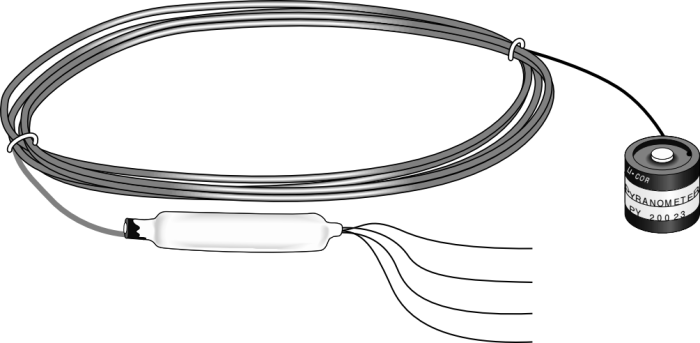This product is no longer available and has been replaced by: CS320. Some accessories, replacement parts, or services may still be available.

| Services Available | |
|---|---|
| Repair | No |
| Calibration | Yes |
| Free Support | No |
Overview
The LI200X, manufactured by LI-COR, is a pyranometer that monitors sun plus sky radiation. It connects directly to our dataloggers, and is used extensively in solar, agricultural, and meteorological applications.
Read More
Benefits and Features
- Compatible with most Campbell Scientific data loggers
- Calibrated for the daylight spectrum (400 to 1100 nm)
- Completion circuit in its cable standardizes calibration, allowing sensors to be interchanged without altering multiplier and offset values
The "-L" on a product model indicates that the cable length is specified at the time of order.
Images

Detailed Description
The LI200X uses a silicon photovoltaic detector mounted in a cosine-corrected head to provide solar radiation measurements. Calibrated against an Eppley precision spectral pyranometer (PSP), the LI200X accurately measures sun plus sky radiation for the spectral range of 400 to 1100 nm. Sensors calibrated to this spectral range should not be used under vegetation or artificial lights.
The LI200X includes an epoxy-encased completion circuit in its cable. This completion circuit standardizes the sensor's sensor's calibration, allowing individual sensors to be interchanged without altering multiplier and offset values.
The standard output is 0.005 mV per W m-2, which provides a signal of 5 mV in full sunlight (1000 W m-2). All of our dataloggers, except the CR200(X) series, can measure this output.
Compatibility
Please note: The following shows notable compatibility information. It is not a comprehensive list of all compatible products.
Dataloggers
| Product | Compatible | Note |
|---|---|---|
| 21X (retired) | ||
| CR10 (retired) | ||
| CR1000 (retired) | ||
| CR10X (retired) | ||
| CR200X (retired) | ||
| CR211X (retired) | ||
| CR216X (retired) | ||
| CR23X (retired) | ||
| CR3000 (retired) | ||
| CR500 (retired) | ||
| CR5000 (retired) | ||
| CR510 (retired) | ||
| CR6 | ||
| CR800 (retired) | ||
| CR800 (retired) | ||
| CR850 (retired) | ||
| CR850 (retired) | ||
| CR9000 (retired) | ||
| CR9000X (retired) |
Additional Compatibility Information
Mounts
To ensure accurate measurements, the sensor should be leveled using a LI2003S leveling fixture, which incorporates a bubble level and three adjusting screws. The LI2003S leveling fixture mounts to a tripod or tower using the CM225 mount. For most applications, Campbell Scientific recommends attaching the CM225 to a CM202, CM204, or CM206 crossarm. The CM225 can also be attached to a tripod or tower mast.
Data Logger Considerations
One differential analog input channel per probe is required.
Specifications
| Light Spectrum Waveband | 400 to 1100 nm |
| Accuracy | Absolute error in natural daylight is ±5% maximum (±3% typical) |
| Sensitivity | 0.2 kW m-2 mV-1 |
| Linearity | Maximum deviation of 1% up to 3000 W m-2 |
| Shunt Resistor | Adjustable, 40.2 to 90.2 ohm (factory set to the above sensitivity) |
| Stability | < ±2% change over a 1 year period |
| Response Time | 10 μs |
| Temperature Dependence | 0.15% per °C (maximum) |
| Cosine Correction | Cosine corrected up to 80° angle of incidence |
| Operating Temperature Range |
-40° to +65°C The overmolding that protects the completion circuit in the cable may crack if the temperature drops below -40°C. |
| Relative Humidity Range | 0 to 100% |
| Detector | High stability silicon photovoltaic detector (blue enhanced) |
| Sensor Housing | Weatherproof anodized aluminum case with acrylic diffuser and stainless-steel hardware |
| Diameter | 2.38 cm (0.94 in.) |
| Height | 2.54 cm (1.00 in.) |
| Weight | 28 g (1 oz) |
Documents
Frequently Asked Questions
Number of FAQs related to LI200X-L: 2
-
The LI190SB-L measures photosynthetically active radiation (PAR), a spectral range of solar radiation from 400 to 700 nm. This is the energy that plants use during photosynthesis. Measurements with the LI190SB-L are reported as photosynthetic photon flux density (PPFD).
The LI200X-L measures total solar radiation from 400 to 1100 nm. Measurements are usually reported in units of W/m2.
-
The information included on a calibration sheet differs with each sensor. For some sensors, the sheet contains coefficients necessary to program a data logger. For other sensors, the calibration sheet is a pass/fail report.
Case Studies
The city of Frisco, Texas, sits in an area that experienced severe drought from about......read more
In 1922, when the intact tomb of Tutankhamen was discovered in Egypt's Valley of the......read more
The Delaware Environmental Observing System (DEOS) is a real-time system dedicated to monitoring environmental conditions......read more
The Austin College Weather Station (ACWX) is located on Austin College's Sneed Environmental Research Area,......read more
The past few years have seen a scramble within the power industry to use more......read more
North Dakota agriculture ranks high in the nation’s crop production: No. 1 in durum and......read more
When the South Jersey Resource Conservation and Development Council, Inc., was challenged to provide a......read more
Privacy Policy Update
We've updated our privacy policy. Learn More






